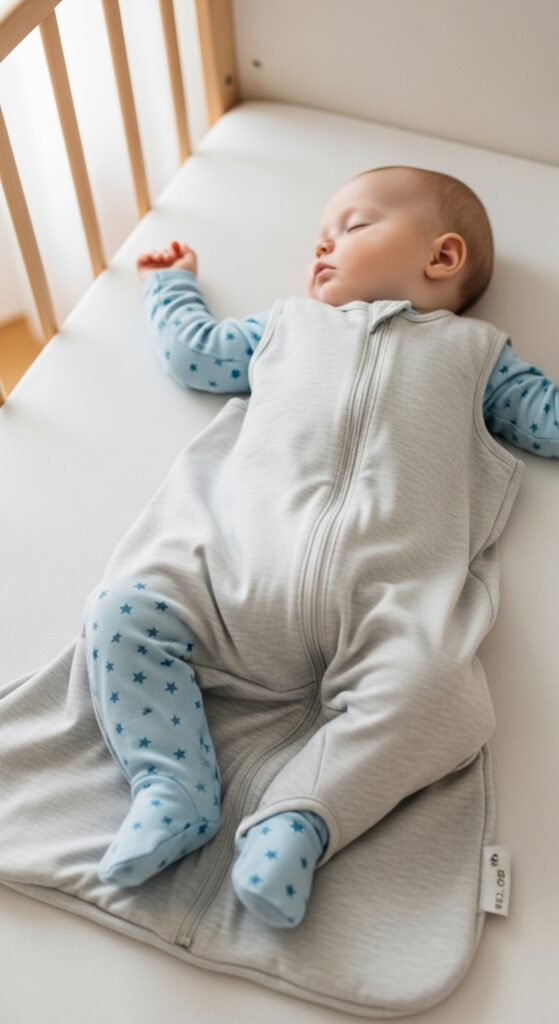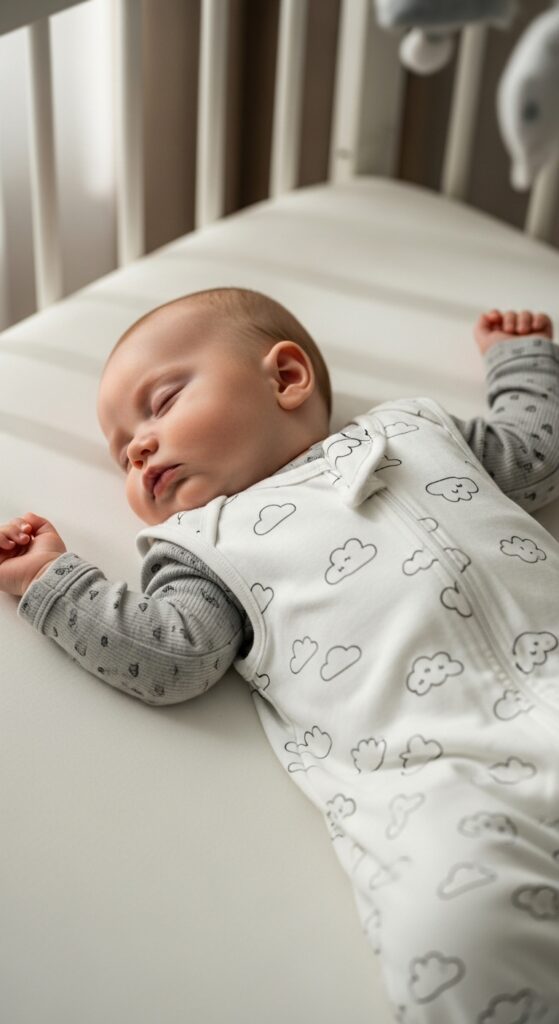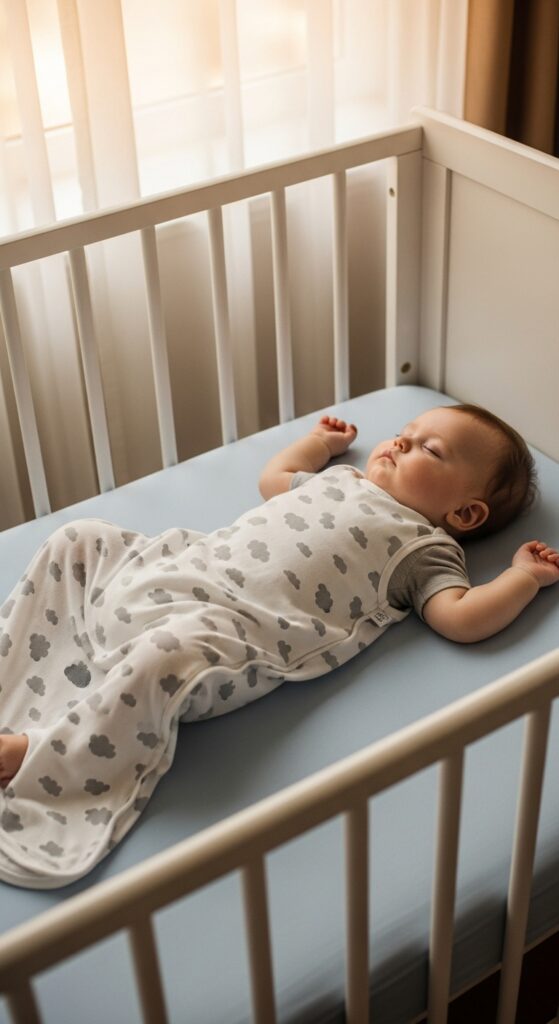
The sun sets earlier, the floors feel chilly, and your baby monitor shows temps that make you second-guess pyjamas. You want your baby cozy, not sweaty. You want simple rules that actually work at 2 a.m. I’ve walked that sleepy hallway, and I know the mental math gets weird fast. So let’s keep it clear, friendly, and totally doable. Ready to master TOG and layering without overthinking it?
What “TOG” Actually Means (And Why You Should Care)

TOG stands for Thermal Overall Grade. It tells you how warm a fabric keeps your baby. Think of it like SPF, but for warmth. Higher TOG = warmer. Lower TOG = cooler.
I keep one thought in mind: you dress for the room, not the season. If the nursery sits at 20°C (68°F), you choose a TOG for 20°C, even if your calendar screams “October”. Ever wondered why your baby sleeps better after a small outfit tweak? Because the right TOG removes the guesswork.
TOG in One Minute
- 0.2–0.5 TOG: Very light. Best for warm rooms or layered under a sack.
- 1.0 TOG: Medium warmth. Great multi-season choice.
- 2.5 TOG: Warm. Ideal for cooler nights.
- 3.0–3.5 TOG: Extra warm. Use for cold rooms with care and good ventilation.
Common Fabric Choices (And How They Feel)
- Cotton: Breathable, easy to wash, budget-friendly. I reach for cotton when temps swing.
- Bamboo/Viscose: Soft and breathable; helps with sweaty sleepers.
- Merino Wool: Naturally temp-regulating and pricey. Worth it in my book if your nights run cool.
- Fleece: Warmth on a budget, but less breathable. I use fleece only when the room sits cold and steady.
Key idea: Breathability beats bulk. I choose fabrics that let heat escape when baby warms up.
The Simple Nursery TOG Chart (By Room Temperature)

I keep a small digital thermometer in the nursery. I dress my baby for what that thermometer says—not the weather app. Here’s a practical TOG chart many parents find useful. Brands vary a bit, so always check the label and watch your baby’s cues.
Room Temp → Outfit Ideas
- 24–27°C (75–81°F)
- 0.2–0.5 TOG
- Layering idea: Short-sleeve bodysuit + light 0.2–0.5 TOG sleep sack or footless pajama alone.
- Watch for: Damp neck or sweaty hairline.
- 22–24°C (72–75°F)
- 0.5 TOG
- Layering idea: Short-sleeve or long-sleeve bodysuit + 0.5 TOG sack.
- Tip: If baby runs hot, skip sleeves.
- 20–22°C (68–72°F)
- 1.0 TOG
- Layering idea: Cotton footed pajama + 1.0 TOG sack.
- Alternate: Long-sleeve bodysuit + lightweight pajama + 1.0 TOG sack.
- 17–20°C (63–68°F)
- 2.5 TOG
- Layering idea: Long-sleeve bodysuit + footed pajama + 2.5 TOG sack.
- Note: Check hands and chest 15 minutes after sleep start.
- 14–17°C (57–63°F)
- 3.0–3.5 TOG
- Layering idea: Long-sleeve bodysuit + warm footed pajama + 3.0–3.5 TOG sack.
- Caution: Ventilate, avoid overheating, and reassess room insulation.
Bold rule: Dress for the room temp you measure, then adjust one layer at a time based on baby’s skin temp and mood.
Layering Guide: Step-By-Step (No Guessing, Promise)
Layering lets you fine-tune warmth without bulky blankets. Safe sleep = no loose blankets in the crib/bed. I build outfits like a sandwich: base layer → pajamas → sleep sack.
H3: Base Layer (Closest to Skin)
- Short-sleeve bodysuit for mild rooms.
- Long-sleeve bodysuit for cooler rooms.
- Fabric: Cotton or bamboo for breathability.
H3: Middle Layer (Pajamas)
- Footed cotton pajama for easy warmth.
- Two-piece set if you need more flexibility for diaper changes.
- Avoid thick, tight layers that trap heat without breathing.
H3: Outer Layer (Swaddle or Sleep Sack)
- Swaddle for newborns who aren’t rolling. Choose a swaddle that matches the room’s TOG.
- Sleep sack once baby shows signs of rolling (arms out). Pick TOG by room temp, not age.
Quick check: You want warm chest and back, not sweaty neck or damp hair. Adjust sleeves before you change TOG.
Newborn vs. Older Baby: What Changes?

H3: Newborns (0–3 Months)
Newborns struggle to regulate temperature. I use simpler layers so I can change one thing at a time.
- Warm room (22–24°C / 72–75°F): Short-sleeve bodysuit + light swaddle (0.5 TOG).
- Mild room (20–22°C / 68–72°F): Long-sleeve bodysuit + 1.0 TOG swaddle.
- Cool room (17–20°C / 63–68°F): Long-sleeve bodysuit + footed pajama + 2.5 TOG swaddle.
When baby starts to roll, I switch to an arms-out sack for safety.
H3: 3–12 Months
Most babies sleep best in a sleep sack with arms free. I tweak base layers with the same room-temp logic.
- Warm: Bodysuit + 0.5 TOG sack.
- Mild: Pajama + 1.0 TOG sack.
- Cool: Bodysuit + pajama + 2.5 TOG sack.
IMO, sacks beat blankets because they stay put and keep warmth consistent.
Signs Your Baby Runs Too Hot or Too Cold
Babies speak in vibes, not words. You can still read the signs.
Too Hot
- Damp hairline or neck, flushed cheeks, quick breathing.
- Fussy, restless sleep, or pulls at the neck area.
- Fix: Lower TOG or remove a sleeve layer.
Too Cold
- Cool chest or back, not just hands (hands run cool and don’t count).
- Frequent wake-ups soon after sleep start.
- Fix: Add a thin base layer or bump TOG by one step.
Important: Check the chest or back, not hands or feet. Extremities can feel cool even when baby feels fine.
Safety Rules You Should Never Skip
I want cozy and safe. You do, too.
- Back to sleep on a firm, flat surface.
- No loose blankets, pillows, or stuffed animals in the crib/bed.
- Use the right size swaddle or sack, and stop swaddling arms-in at first roll attempts.
- Keep the neckline snug so fabric can’t ride up.
- Dress for the room temp, not the outdoor weather report.
- Follow brand and pediatric guidance for age, weight, and TOG.
Gold rule: When in doubt, go slightly cooler and layer smart. Overheating disrupts sleep and comfort.
Real-World Outfit Recipes (By Temperature)
Want concrete examples? I love recipes because they reduce late-night decisions.
- 24–25°C (75–77°F): Short-sleeve bodysuit + 0.5 TOG sack.
- 22–23°C (72–73°F): Long-sleeve bodysuit + 0.5 TOG sack or footed pajama alone.
- 20–21°C (68–70°F): Footed cotton pajama + 1.0 TOG sack.
- 18–19°C (64–66°F): Long-sleeve bodysuit + footed pajama + 2.5 TOG sack.
- 16–17°C (61–63°F): Long-sleeve bodysuit + warm footed pajama + 3.0 TOG sack.
- Below 16°C (≤60°F): I improve room insulation or add safe heating rather than piling on thick layers.
FYI: I adjust sleeves first because that quick change usually solves it.
Fabric Face-Off: Cotton vs. Merino vs. Fleece
I test fabrics when temps swing.
- Cotton: Balanced and breathable. Perfect first choice for most rooms.
- Merino: Temp-regulating champion. I use it on nights that hover around the “too cool” line.
- Fleece: Warm and budget-friendly. I reserve it for consistently cold rooms and keep layers minimal underneath.
Verdict: Start with cotton. If your nursery runs cool, add merino pieces where it counts (pajamas or sack).
Budget Tips That Still Feel Luxe
You don’t need a brand-new drawer.
- Buy one sack in each core TOG (0.5, 1.0, 2.5). That trio covers most nights.
- Choose neutral colors so every piece mixes.
- Size up carefully with sleep sacks; too big means neck holes gape.
- Shop secondhand for cotton pajamas and bodysuits; keep sacks new for precise sizing and safety.
I spend on the 2.5 TOG sack because it carries us through fall, winter, and weird shoulder seasons.
Troubleshooting: Quick Questions, Fast Fixes
Q: My baby wakes sweaty at 2 a.m., but the room temp hasn’t changed. What gives?
A: Baby’s body temp can peak during the first deep sleep cycle. Drop one layer at bedtime, then reassess. I often switch from long sleeves to short sleeves and keep the same TOG.
Q: Hands feel cold. Should I add mittens?
A: Check the chest/back instead. Hands run cool and don’t reflect core temp. If chest feels warm, you’re good.
Q: Can I double up on sacks for extra warmth?
A: I don’t stack sacks. Use the right single TOG and adjust inner layers. Stacked sacks can overheat and complicate fit.
Q: Nursery dips in the early morning. How do I plan?
A: Dress for the lowest expected temp or choose a slightly higher TOG and keep base layers light. You keep comfort steady across the night.
Q: Which matters more, TOG or fabric?
A: TOG first, fabric second. TOG sets warmth; fabric sets comfort and breathability.
Quick Reference: TOG Cheat Sheet
- 0.2–0.5 TOG: Warm rooms. Bodysuit + light sack.
- 1.0 TOG: Mild rooms. Pajama + sack.
- 2.5 TOG: Cool rooms. Bodysuit + pajama + sack.
- 3.0–3.5 TOG: Cold rooms. Use with caution; improve room insulation too.
Remember: Measure room temp and watch your baby’s cues. That combo wins.
My Nightly Routine (Because Real Life Beats Theory)
I check the nursery thermometer during bedtime routine. I pick the TOG that matches the number I see. I choose sleeves based on how the day went—sweaty baby gets lighter sleeves; chilly baby gets long sleeves. I touch the back of the neck 10–15 minutes after lights out. I change one thing at a time if sleep looks rough. Sounds simple because it is.
Ever wondered why the same outfit fails on Thursday after working on Monday? Because humidity, bath temp, and daytime activity all shift the equation. You adapt, and your baby sleeps better. Win.
The Safe, Cozy, Sanity-Saving Takeaway
- Dress for measured room temperature, not the calendar.
- Use TOG to set warmth, then tune sleeves and base layers.
- Check chest/back, not hands, for hot/cold cues.
- Keep sleep spaces clear and safe; stop swaddling when rolling starts.
- Build a small, flexible wardrobe (0.5, 1.0, 2.5 TOG) and adjust slowly.
You’ve got this. Your baby wants a calm, consistent setup, and you can run that play every night. You know your baby best. Trust your readings, trust your instincts, and tweak with confidence. And hey, if you still want a quick sanity check at midnight, I get it—I have changed a sleeve at 12:07 a.m. and felt like a superhero.
